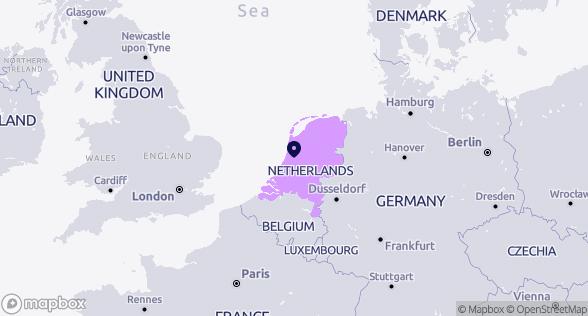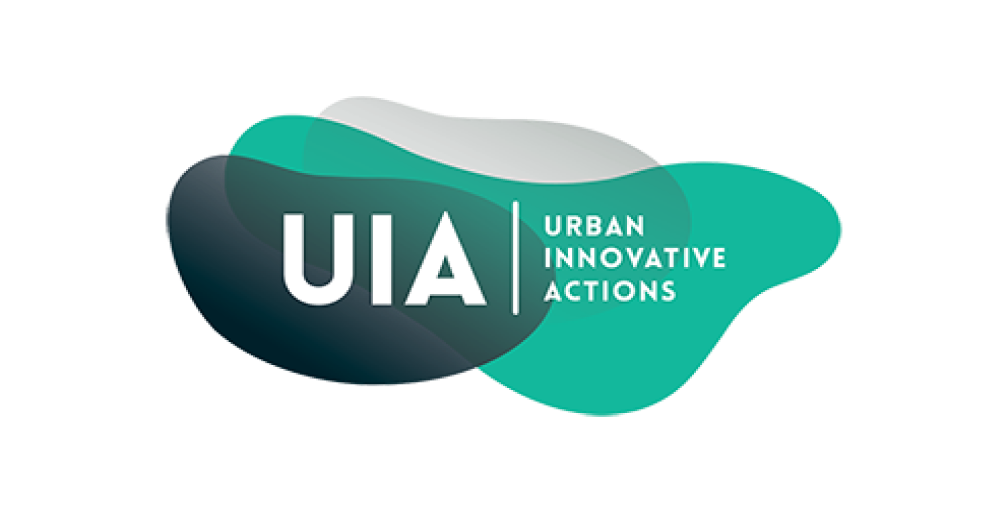
Amsterdam
Netherlands

This is a case study as part of an UIA report. You can access all of the project's resources on its project collection page.
1. Short project description
Amsterdam is experiencing the effects of climate change, in terms of flash floods due to heavy rainfall, higher temperatures, and increased droughts.
The RESILIO project proposes an innovative adaptation plan to climate change by laying blue-green roofs (where blue stands for water, green for plants) on 10,000 square meters of buildings (out of which 8,000 square meters are in social housing buildings) in four districts of the city where there are higher risks of flooding caused by heavy rain.
Blue-green roofs can absorb much more water than ordinary green roofs. As a result, they support the evaporation process during hot, dry weather, a fact that cools the homes and potentially – depending on the area covered - the entire neighborhood. As a result, blue-green roofs mitigate the urban heat island and consequently reduce energy consumption for cooling at the building level.
The new roofs incorporate a smart system of sensors with the capacity to retain or release water in response to the weather forecast. Roofs will be part of an interconnected network. In addition, a wider variety of plants can grow on blue-green roofs, which is beneficial for urban biodiversity.
The project is based on a partnership between the municipality of Amsterdam, the water company Waternet, Universities, green roof companies, and housing corporations[1].
RESILIO builds upon 5 years of R&D of smart blue-green roof technology as developed by several of the project partners. After the proven success of single blue-green roofs across Amsterdam, RESILIO moves to build a smart grid of roofs, also enabling real-time data exchange for dynamic water levels.
In its general perspective, the project capitalizes on the successful green roofs state/city program, supports the emerging green sector of Nature-Based Solutions (NBS), and develops a new market-linked to adaptive urban water management of new type and scale. The project also results in the mitigation of heat, thus improving thermal comfort both indoor and outdoor.
The output of the project so far is a network of 10,000 square meters of blue-green roofs. Finally, the project has resulted in a new municipal approach for urban space interventions and has demonstrated the merit and importance of innovation for climate change adaptation.
[1] Amsterdam University of Applied Sciences, Vrije Universiteit Amsterdam, housing corporations Stadgenoot, Ymere and De Key, and roof maintenance company Consolidated.
2. Amsterdam and Just Transitions
RESILIO builds on the long tradition of Amsterdam on green roofs. It promotes innovation as compared to the green roofing program of the city; innovation refers to the mix of blue and green elements to roofing installations as well as to the interconnection of the blue-green roofs into a network with the potential to support wider spatial-wise environmental and climate adaptation benefits.
The project is supported by a public-private partnership between city authorities, social organizations, academia, and businesses. The partnership takes advantage of the public experience in the field of green roofs, the innovation and knowledge sharing potential of academia, and the vitality of the private sector towards the exploitation of a solution with market potential. To this end, the project leads to business opportunities for the expansion of the green roofs market, whereas its implications for the labor force are positive, taking the need for trained workers and experts in the field of blue-green roofs and smart systems.
RESILIO practically falls in the growing industry of Nature-Based Solutions and can be considered as a live component of a whole ecosystem developed, comprising of smart roofs and water neutral buildings.
The Strategy for Adaptation of Amsterdam (2020) does support emerging green sectors in the overall field of Nature-Based Solutions and refers explicitly to the potential of blue-green roofs, thus benefiting the shift of the UIA project from its pilot character to an operation one. However, a barrier may the lack of funding, for instance in support of a long-term subsidy program for green roofs that also include a blue element.
A potential barrier in the field of emerging green sectors is usually their slow structural integration in public operations and management as well as in public procurement procedures. In the case of Amsterdam, such a barrier seems to be adequately dealt with taken the long involvement of the city with the green roof program as well as the innovative character of the Strategy for Adaptation.
A barrier is the lack of skilled personnel for supporting blue-green roofs as well as the smart systems needed for their operational control in terms of the water flow and discharge. This UIA project has demonstrated the potential of academia to support the skilling/reskilling of workers; in the course of the project, two Innovation Labs were developed for training and demonstration purposes on blue-green roofs. The continuation of the operation of these Labs after the end of the UIA project is necessary for the research-training-experimentation of the students; similarly, the inclusion of innovative climate adaptation technologies and techniques in the respective University curricula is considered an essential action.
A barrier may be the limited interest of the public to blue-green roofs. RESILIO’s demonstration activities along with respective ones for knowledge sharing and communication can widen the public’s interest.
Finally, a barrier may be the reluctance of the private sector to promote investments along the line of the UIA project, as the investment may not be in their core business or they do not recognize a profitable market. Taken that private companies are important stakeholders as they will be the ones to define whether the blue-green roofs market will emerge, it is important to assess the need for incentives as well as to take advantage of the long-lasting public-private cooperation – through the municipal company Waternet - between the municipality of Amsterdam and private companies.
Conclusively, the municipality of Amsterdam can play a major role in the implementation of blue-green roofs, taking that it holds extensive experience from the green roofs’ program and the respective subsidy policy. The citizens are the ones who can initiate blue-green roofs implementation and receive some direct advantages, either in the form of subsidy or by having a roof that prevents flood and supports improved thermal comfort. Together with the civil society organizations, groups, and networks they can promote initiatives to communicate and raise awareness about blue-green roofs projects.
3. How does the UIA intervention promote Just Transitions?
The UIA intervention supports the emerging green sector of Nature-Based Solutions. It builds on the successful program on green roofs and is aligned with the main objectives of the Strategy for Adaptation of Amsterdam, namely the mitigation of climate change impacts related to floods, drought, and heat.
The project shows what type of businesses are needed to support climate adaptation at the urban scale: architectural firms specializing in green design principles, companies producing and installing blue-green roofs materials, consultants/firms for smart systems and sensors development, firms specializing in nature-based solutions.
In terms of the jobs needed, they may be architects specialized in bioclimatic and climate-friendly buildings, project managers, operating engineers and roof construction and equipment technicians, experts in nature-based solutions (e.g. green roofs), financial experts with specialization in nature-based solutions, landscaping, and groundskeeping workers (maintenance, repair, and cleaning works) and roof inspectors.
Taken the above, it would be important if the city authorities devised skilling and reskilling programs to support the new requirements for the labor force, in particular in terms of the integration of blue-green roofs in the overall sector of Nature-Based Solutions.
4. Keys to success
Analysis of the Amsterdam case identifies several factors that have helped the successful implementation of the project. These factors are:
a. The aim to make climate adaptation the “new normal”
By considering climate adaptation the “new normal” in the Strategy for Adaptation of Amsterdam, priority is towards a new approach to urban design and management. This provides in turn the space for innovative projects for flood management, an increase of greenery, and heat mitigation.
b. Strong legacy in green roofing
Amsterdam has a strong and lasting legacy in green roofing programs. To this end, the upscaling of the program to tackle roofs through both the blue and green elements can be adequately supported.
c. Public-private partnership
The UIA project takes advantage of a public-private partnership incorporating the municipality of Amsterdam, the water company Waternet, Universities, green roof companies, and housing corporations. The effective partnership dimension reflects point 3 of our report’s Roadmap.
d. Innovation in action
The project introduces an innovative approach, namely roofs that can keep extra water under the green plant layer. In this way, the chance for damages to houses in case of heavy rain is reduced, whereas the cooling effect of the green layer increases in the case of drought.
e. Strong social and participatory dimension
The UIA project empowers 1500 residents of all socioeconomic levels to engage through a bottom-up and co-creation approach.
5. Upscaling and replication potential
The upscaling of the UIA project reflects considerable potential taken that blue-green roofs have been included in the Strategy for Adaptation of Amsterdam. Yet, the potential is also a function of the provision of blue-green roofs subsidies to house owners as well as of the market’s response. A precondition for upscaling is the collaboration with a wide array of stakeholders from both the public and private sectors. The involvement of the banking system through the provision of green – low interest – loans may have a catalytic impact.
In terms of the replication potential, the challenge is to keep the momentum through knowledge transfer and cooperation with other cities. To this, the RESILIO has been linking with the UIA projects of Manchester (IGNITION) and Seville (CartujaQanat), as well as other cities (Graz, Berlin).
Finally, it is important to note that the European Commission policy for the adaptation of cities to climate change and their transformation to Climate Neutral ones as early as 2030, sets a promising framework for the said emerging green sector.
About this resource
The Urban Innovative Actions (UIA) is a European Union initiative that provided funding to urban areas across Europe to test new and unproven solutions to urban challenges. The initiative had a total ERDF budget of €372 million for 2014-2020.
Similar content






Want to replicate this urban practice in your city?
Apply to an EUI City-to-City Exchange
Connect with a peer city who can bring you solutions and expertise and apply together to receive EUI support
More infos on EUI websiteBrowse existing Innovative Actions looking for Transfer Partners and cities willing to do a City-to-City Exchange looking for peers